Modern theatre of the absurd: In “Buggers and Suckers”, Dušan Vicen and the SkRAT theatre troupe examine the lives of the stressed people in today’s world
The theatrical association SkRAT (2004) started life as the Association for the Present Day Opera (2000) in the halls of the theatre Stoka (1991). The theatrical troupe draws on the phenomenon of author theatres, which originated in Slovakia in the 1980s.
The author theatres have brought a different set of dramatic and theatrical principles and techniques to Slovakia, which were already being used by the theatre of the absurd (decomposition, fragmentariness, deconstruction). The position of the actor in particular has shifted from performer to co-author of the whole performance.
The principle method of theatre SkRAT is collective authorship and creative improvisation
Theatre SkRAT is interested in ordinary or even banal life situations, which are turned into absurd revelations with the use of hyperbole and repetition. SkRAT is also known for its innovative visual conception and use of new technologies.
Dušan Vicen (1966) is an author of dramatizations, radio plays and theatre plays (“Caress the dog! Apotheosis of Emptiness”, “Silluet b mol”, “Homo Joga”). As a founding member, director, co-author and actor he participated in a few theatre projects. Since the principle method of theatre SkRAT is collective authorship and creative improvisation, the final version of the play emerges during the rehearsal process. The co-authors are Vít Bednárik, Ľubo Burgr, Lucia Fričová, Daniela Gudabová, Milan Chalmovský, Romana Maliti.
“Buggers and Suckers” consists of seventeen short scenes
The newest play in SkRAT´s repertoire “Buggers and Suckers” , written by Dušan Vicen, consists of seventeen short scenes, sketches mainly from the milieu of management. Both thematically (social issues, human isolation, dysfunction of human relationships) as well as in terms of form (appealing visual effects and music, projections), “Buggers and Suckers” follows in the tradition of previous plays, such as “Dead Souls”, “Paranoia”, “Die- Snuff and Conk out”.
“Buggers and Suckers” captures the modification of social and anthropological categories. At first, humans were hunters and gatherers. The contemporary individual is determined by his working environment and above all by his position (as bugger or sucker) in the company. The author reveals the inhumanity and absurdity of the system underneath the glaze of professional ethics and transparency.
Vicen’s reflection reveals a new kind of dictate – that of money and social status
In previous performances, such as “Dead Souls” and “Paranoia”, the theatrical troupe SkRAT confirmed its interest in the theatre of the absurd. Their interpretation of absurdity is not absolute; rather it is determined by Slovak social reality. More than Beckett or Ionesco their work resembles that of the Eastern and Central European authors like Václav Havel or Sławomir Mrozek. While these authors articulated the aimlessness of human existence within the frame of social and political conditions and so criticized the dictate of the socialist regime, Vicen’s reflection in “Buggers and Suckers” reveals a new kind of dictate – that of money, social and professional status, consumption and media. This addiction is all the more tragic – in terms of SkRAT’s poetics, rather tragicomic – as it is chosen willingly.
The author continues to develop this paradox in the play. It is a paradox of a human, who in an effort to feel and look authentic and original, copies foreign and artificial patterns. In doing so he loses the connection to his own traditions and natural manners, which is reflected in his communication. The main communication symbols consist of technical terms like “decode”, “forward”, “update”. Anyone who does not handle new code speech is condemned to vegetate at the bottom of this new anthropological hierarchy.
Video projections became a characteristic sign of this author theatre
The author also articulates his vision of the contemporary individual through the topic of freedom. This is done with the help of video projections, which has become a characteristic sign of this author theatre. A cyclically repeated projection of a man, who holds papers in his hands and constantly walks up the stairs, becomes a leitmotiv of the play. This modern human is constantly in a hurry for nothing. He never reaches his goal. This image offers an analogy with Camus’ Sisyphus, who is condemned to roll his stone forever, confirming the absurdity of his life.
Vicen’s interpretation of the controlled and watched human is accentuated by projections from industrial cameras. The issue of human freedom reaches its climax in the penultimate scene with the significant title Arbeit macht frei. With the help of this cruel paraphrase from our recent war history the author portrays the (post) modern labour prison of contemporary people.
The author did not write “Buggers and Suckers” just to display a competitive and destructive business milieu. The disease of our postmodern society, based on consumption and individualism, has already affected human relationships. In the tenth scene, “Genetic Material”, the author exposes the depraved and unnatural motivations that led a woman to become pregnant. Motherhood, in their interpretation, is not a fulfilment of an inner spiritual need, but a trend copied from tabloid and commercial media. Even the demands of the expectant mother towards her child (the main thing is that it has to look good) – however superficial and absurd they sound – just reflect our blind following of tips and tricks offered by media.
Vicen confronts the reader with weighty real issues. The seriousness of the key themes is balanced out by grotesque humour, which is important in the poetics of SkRAT. The author reveals the bipolarity of our cosmos with irony, sarcasm and practical jokes.
